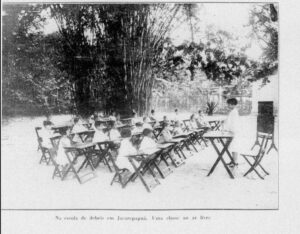André Dalben, Professor, Federal University of São Paulo, Institute of Health and Society, Santos, SP, Brazil.
Henrique Mendonça da Silva, Professor, Education Department of the State of Rio de Janeiro, Rio de Janeiro, RJ, Brazil.

Image: LEÃO, 1926, p. 72
Cadernos Cedes (vol. 40, no. 112), presents in the dossier “Education and nature from a historical perspective: outdoor life, health and hygiene” seven articles that “seek to catch the ways that ideas of outdoor life, marked by ambiguities, were forged and gained wide dissemination, being expressed in different records and contributing to the affirmation of nature and its elements as central in education, in the prevention of diseases , in the preservation of health and in the leisure of populations that lived in urban areas in the first decades of the twentieth century” (SOARES; ROCHA, 2020).
One of the articles published is entitled “Sun and fresh air in the fight against tuberculosis: experiences of outdoor education in Rio de Janeiro (1910-1920)”, which presents a wide range of historical sources. The study presents and analyzes some discussions and measures put in place in the city of Rio de Janeiro to cope with childhood tuberculosis during the 1910s and 1920s, when there were still no effective drugs to control this disease.
The authors explain that, at that time, the population of the then federal capital faced a series of epidemics, with the prevalence of tuberculosis being alarming and, for some medical authorities, in the process of becoming endemic. The school environment, in turn, had the potential to aggravate the spread of infectious diseases due to the gathering of children. In the 1910s and 1920s, several medical investigations performed in Rio de Janeiro schools attest to the progressive growth of lung disease among the child population, as well as a variety of other diseases. From this scenario, the researchers wondered: what were the measures proposed to control the spread of diseases such as tuberculosis among schoolchildren? Which measures were implemented in the city of Rio de Janeiro? How did health measures integrate with the pedagogical proposals of school institutions?
The study showed that, in the absence of vaccines or antibiotics, the ideas available by science at the time were used: sunlight, climate and exposure to what was considered fresh air. Different professionals sought to associate health and education from the ideals of an outdoor life, and nature was often raised as a place for healing and prevention of several ills. A set of proposals was discussed by the community of physicians and teachers of Rio de Janeiro, such as the creation of solariums for the application of heliotherapy (sunlight treatment), the inauguration of preventorium environments for the children of tuberculous adults, the organization of school camps to promote greater contact of children with nature, the remodeling of school buildings to ensure the circulation of air and the abundant entry of sunlight , conducting classes in fully open spaces and even the construction of outdoor schools in some of the city’s parks and beaches.
In addition to rescuing a set of initiatives often forgotten, the article allows the reader to reflect on the importance of nature and the outdoors for the health and education of children, especially at the present time, when infectious diseases again concern us on a planetary scale. The dossier in which the study was published also presents articles that deal with naturism and nudism, school diet, human emotions in the face of climate change, the relations of urbanization with the environment and the body conceived as nature. The dossier’s set of articles invites us to reflect on the contradictions and ambiguities of the fact that outdoor life has often been raised as a solution to the ills of urban-industrial society.
References
DALBEN, A. Escola de aplicação ao ar livre de São Paulo Open-Air School of São Paulo. Educ. rev. [online]. 2019, vol. 35, e219650. ISSN: 1982-6621 [viewed 4 December 2020]. https://doi.org/10.1590/0102-4698219650. Available from: http://ref.scielo.org/xzng3j
DALBEN, A. Las escuelas al aire libre uruguayas: creación y circulación de saberes. Educación Física y Ciencia [online], 2019, vol. 21, e075-12. ISSN: 2314-2561 [viewed 4 December 2020]. https://doi.org/10.24215/23142561e075. Available from: https://www.efyc.fahce.unlp.edu.ar/article/view/EFyCe075
LEÃO, A. C. O ensino na capital do Brasil. Rio de Janeiro: Typ. do Jornal do Comércio, de Rodrigues & C., 1926.
ROCHA, H.H.P. A higienização dos costumes: educação escolar e saúde no projeto do Instituto de Hygiene de São Paulo (1918-1925). Campinas: Mercado de Letras, 2003.
ROCHA, H.H.P. Regras de bem viver para todos: a Bibliotheca Popular de Hygiene do Dr. Sebastião Barroso. Campinas: Mercado de Letras/FAPESP, 2017.
SILVA, H.M. A higiene escolar além das palavras: Oscar Clark e o tratamento médico escolar. 2017. 312 f. Tese (Doutorado em Educação) – Universidade Estadual de Campinas, Campinas, 2017. Available from: http://repositorio.unicamp.br/jspui/handle/REPOSIP/319162
SOARES, C.L. Uma educação pela natureza: a vida ao ar livre, o corpo e a ordem urbana. Campinas: Autores Associados, 2016.
SOARES, C.L. and ROCHA, H.H.P. Viver ao ar livre: entre prescrições higiênicas, alegria e aventura. Cad. CEDES [online]. 2020, vol. 40, no. 112, pp. 198-206. ISSN: 1678-7110 [viewed 4 December 2020]. https://doi.org/10.1590/cc231818. Available from: http://ref.scielo.org/wr3pkh
To read the articles, acess
DALBEN, A. et al. Sun and fresh air in the fight against tuberculosis: experiences of outdoor education in Rio de Janeiro (1910-1920). Cad. CEDES [online]. 2020, vol. 40, no. 112, pp. 218-232. ISSN: 1678-7110 [viewed 4 December 2020]. https://doi.org/10.1590/cc232227. Available from: http://ref.scielo.org/tny8bq
External links
Cadernos CEDES – CCEDES: www.scielo.br/ccedes
André Dalben: http://lattes.cnpq.br/0743727143543352
Henrique Mendonça da Silva: http://lattes.cnpq.br/2990168367331033
Como citar este post [ISO 690/2010]:

















Recent Comments